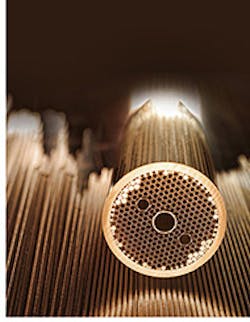OFS has developed a Hollow-Core Fiber (HCF) that it says exceeds state-of-the-art performance and eliminates limitations which have inhibited applications of this potentially disruptive technology.
The novel fiber design was developed by OFS Laboratories in the DARPA-funded Compact Ultra Stable Gyro for Absolute Reference (COUGAR) program, led by Honeywell International, Inc. The fiber employs an air filled core surrounded by glass webbing, and is first to demonstrate improvement in three key characteristics critical for such applications as high precision fiber-optic gyroscopes for inertial navigation.
Hollow-core fibers allow light to propagate through free space rather than a solid glass core, making them an ideal waveguide in theory. Earlier versions of HCF showed high propagation speeds, but they weren't able to do so in combination with the properties that make it useful for demanding applications. Certain limitations prevented the breakthrough performance promised.
See: Hollow fiber-optic cable supports near-light speed transmission
The fiber developed in the OFS program overcomes these limitations and dramatically improves three critical performance enabling properties:
-- Single-spatial-mode: Breakthrough “PRISM” mechanism forces light to take only a single path, enabling higher bandwidth and lower noise over longer distances.
-- Low loss: Light maintains power over longer distances.
-- Polarization control: The orientation of the light waves is fixed in the fiber, which is necessary for applications such as sensing, interferometry and secure communications.
DARPA continues to work on integrating this new technology into gyroscopes.
Hollow-core fiber can be bent and coiled to tight bend radius while guiding light at speeds 30 percent faster than conventional fiber. In addition to high precision gyroscopes, there are many applications that will benefit from this technology, notes OFS. HCF is naturally radiation hardened and could find applications in space systems while other applications include low latency telecommunications or high performance computing systems and medical sensors.
“OFS is proud to be a participant in this prestigious program and to have developed this breakthrough fiber,” comments Michael Fortin, vice president of marketing and sales at OFS.
Related news: OFS optical materials engineering lab dedicated at Clemson U.
About the Author
Matt Vincent
Senior Editor
Matt Vincent is a B2B technology journalist, editor and content producer with over 15 years of experience, specializing in the full range of media content production and management, as well as SEO and social media engagement best practices, for both Cabling Installation & Maintenance magazine and its website CablingInstall.com. He currently provides trade show, company, executive and field technology trend coverage for the ICT structured cabling, telecommunications networking, data center, IP physical security, and professional AV vertical market segments. Email: [email protected]

